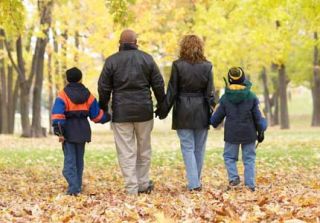Stress
Take a Walk on the Wild Side
Here's a simple (and free) way to fight holiday stress.
Posted December 11, 2013


Meanwhile, the very media that bombard us with must-have and must-do messages also exhort us to just chill. Simplify, tune into the spiritual meaning of the season, treasure family connections, and while you’re at it, work in some yoga and meditation. No wonder we feel more stressed knowing we have no time or energy to launch a program to relax us.
There is, however, a proven de-stressor that is free, available to most everyone, and uncomplicated. Brought to you by Mother Nature, it’s as simple as a walk in the woods, an hour in a city park, or a tramp through the snow. When we get out into a natural environment, and just as important, make sure our children get their recommended dose of nature’s power, we reap many physical and emotional benefits.
Decades of research confirm that nature literally heals. In 1984, Roger Ulrich, in a now classic study, showed that after gall bladder surgery, patients whose hospital rooms had windows with a garden view (as compared to a view of a brick wall) had quicker recovery, needed fewer pain meds, and suffered fewer complications. Since then, dozens of studies have confirmed that viewing nature—and even better, being in it --leads to pain and stress reduction. Children experience similar benefits. In one study, children with ADHD who played for just 20 minutes in a natural setting gained increased mental focus equivalent to a dose of ADHD medication.
Such findings have given rise to many “nature therapies.” For example, in Copenhagen, stress-related illness is being treated in a “healing forest garden,” where therapists combine the calming power of greenery with mindfulness training. In Israel, the “Encounter in Nature Therapeutic Education Program” works in schools for children with special needs. School gardens become a therapeutic milieu where children discover animals and build “homes” out of sticks and other natural materials. Another nature therapy program in Israel helps build resilience in kindergarten children dealing with war-related stress.
What underlies the power of nature to relieve stress? The biophilia hypothesis argues that because human evolution unfolded within and was completely dependent upon the natural environment, human brains are hard-wired to respond to green vistas, blue skies and azure waters as harbingers of wellbeing, and hence, beautiful and calming. In one study, patients suffering from stress-related illnesses described their experiences in a therapeutic “healing garden” as slowing down, taking one thing at a time, giving oneself a break, and in general, attuning to nature’s pace. For them, the garden became a place of rest and recovery. In other studies, spending time in nature has been linked to increased attention, motivation, and sensory engagement.
Even virtual simulations of nature, while no substitute for the real thing, can be beneficial. In one study, when prospective blood donors in a waiting room saw a nature video (as compared to a daytime TV show), their blood pressure and heart rate decreased. In other research, office workers who could look at a 50” plasma display of a nature scene felt more satisfied than their co-workers who looked out at a blank wall. However, the same study found that only when office workers could look out the window at an actual nature scene did their heart rates show rapid recovery after low level stress. In other words, nature documentaries, videos and pictures are better than nothing. However, getting out into the sights, sounds and smells of the natural world is the real deal.
So, as you bring the greenery of a Christmas tree and wreath inside your house, remember that living evergreens might be just a short walk or drive away. Pay them a visit. You’ll feel better for it.


